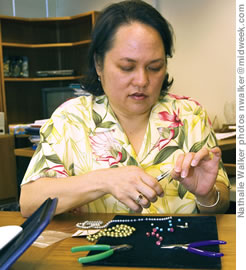Preparing For The Next Pandemic
Don’t panic, but Dr. Chiyome Fukino wants everyone to have an emergency kit
By Alice Keesing
E-mail this story | Print this page | Archive | RSS |
 Del.icio.us
Del.icio.us
Dr. Fukino beading during lunch to relax
Dr. Chiyome Fukino is ready. Stashed underneath her director’s desk at the state Department of Health is a brand spanking new backpack with roller wheels and a bright plastic Winnie the Pooh keychain. Inside are her bottles of water, leather gloves, Sterno cooking stove and fuel, face masks, saw (for removing fallen branches), flashlight ...
Dr. Fukino is not a camping enthusiast. This is her emergency survival pack. And she wants everyone in the state to have one.
Ever since 9/11, state and federal officials have become very interested in preparing for disasters. Hurricane Katrina was a frightening example of what can happen when people are not prepared. So these days, there are plans for everything from terrorist attacks to hurricanes to pandemic flu.

looking at samples with Janice Okubo
Pandemic flu is not the seasonal flu that makes us miserable for a few days every winter. A pandemic flu is a new strain of virus to which we have no resistance. And experts say that, statistically speaking, we’re overdue for such a global outbreak.
Fukino does not want people to panic, but she’s also not sugar-coating the message.
When pandemic flu strikes, people will die, she says. It will drastically change the way we live. It could infect nearly 300,000 people in Hawaii and kill nearly 2,500, according to one federal estimate. It would overload already strained hospital systems and could bring business to a grinding halt with devastating effects on our economy.
Preparing now will help soften the blow, the experts say. And that doesn’t just mean state agencies and businesses - that means you because the system may be too swamped to respond when you call 911 or need to get into the emergency room.
“In America we believe the healthcare system is accountable for every life and death,” Fukino says. “In a pandemic, all dibs are off. The rules change.
“We need to be able to care for ourselves for a long enough period of time so we can muster our forces, otherwise we are in deep kimchee. We are sitting in the middle of the ocean; there is no cavalry coming in from the neighboring states.”
So when exactly is this going to happen? Even the experts don’t know. But they are increasingly worried about the avian influenza virus, otherwise known as the bird flu or H5N1.
“You look at what has happened in the past three years, and it suggests the risk is at its highest level in 40 years,” says Duane Gubler, director of the University of Hawaii medical school’s Institute of Tropical Medicine and Infectious Diseases.
So far, just under 300 people worldwide have caught the virus from infected birds. But the death rate among those people has been an alarmingly high 60 percent. The worst-case scenario happens when the virus mutates so that it can jump between humans.
Every time the virus infects another bird - and it is doing so at a virulent rate - that is one more chance that it will mutate to the point where it becomes infectious among people. With no resistance in the human population, the virus would quickly spread around the globe becoming a pandemic.
When the pandemic does strike, it is the state health department that takes over the response and calls the shots - sometimes literally. So when Fukino started on the job just over four years ago, she blew the dust off the health department’s emergency response plan. She found old five-digit phone numbers and the names of people who had long ceased to draw breath. Clearly, it needed some updating.
Since then, Fukino and her team, led by Dr. Sarah Park, have put together what the federal government has recognized as one of the best preparedness plans in the nation.
Toby Clairmont, the emergency program manager for the Healthcare Association of Hawaii, which helped write segments of the plan, was recently at a national disaster planning conference where Hawaii was the subject of some back-patting.
“We were pointed out in a conference with 4,000 of our peers as being innovative and effective,” Clairmont says. “We were kind of embarrassed but really proud, too.”
“They’ve done a super job,” Gubler agrees. “(Dr. Fukino) has taken this very seriously and she has got some very good people working for her - and that’s the mark of a good leader, isn’t it?”
Rather ironically, Fukino never aimed to be the leader of the health department. Hers is one of those hard-work, good-vibe stories. Born in Kalihi to her native Hawaiian mom and Japanese dad, Fukino was the second of eight children. From an early age, she was the little momma, changing diapers and patting babies to sleep. Her dad sold vacuum cleaners door-to-door, her mom raised the family, and they lived in an old house with an outside shower and mismatched linoleum floors and free-range geckos.
“It was filled with music, filled with laughter and filled with kids,” Fukino says. “So it’s just who you are.”
And the education ethic was always there. Her grandfather didn’t start school until he was 12, but went on to become one of the first native Hawaiians to graduate from the Territorial College before becoming a civil engineer with the city and county. Her mom went back to school after having eight kids and became a teacher.
And Fukino’s dad always encouraged her to aim high. If she
Page 1 of 2 pages for this story 1 2 >
E-mail this story | Print this page | Comments (0) | Archive | RSS
Most Recent Comment(s):








